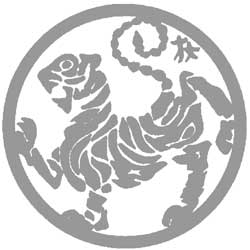
Japan Karate Association of Wisconsin
Japanese Terminology
Our dojo uses many Japanese terms. You will learn many
naturally as your training progresses. Please check your specific promotion
exam requirements to see which terms are required for your rank.
Click here for a simplified Japanese Terminology list suitable for younger and Pre-Karate Students.
Counting / Numbers:
one ichi
two ni
three san
four shi or yon
five go
six roku
seven shichi or nana
eight hachi
nine ku
ten ju
eleven ju-ichi
twelve ju-ni
…
twenty ni-ju
twenty-one ni-ju-ichi
…
thirty san-ju
thirty-one san-ju-ichi
…
General Terminology:
upper area jodan
middle area chudan
lower area gedan
combative/guarding posture kamae (thus the command: " kamae-te!", "hands in guard position!" In an American Western: "Put up your 'dukes'!")
begin hajime
stop yame
finishing power or focus (this word is related to ki and denotes power derived from properly focused mental energy) kime
bow rei
ready yoi
left hidari
right migi
teacher (born before) Sensei
instructor Shi-han
senior student/assistant instructor Senpai
junior student Kohai
karate practitioner karateka
“babysitter”/senior student helping junior students in specific drills moto-dachi
training hall dojo
uniform gi
empty hand karate
the way of the empty hand karate-do
basics/fundamentals kihon
forms kata
technique(s) waza
mental energy (tremendous source of power, speed and perception: i.e., "karate radar") ki
center of ki/center of gravity (located approx. 1 inch behind and 1 inch below navel) tanden
spirited yell (focused ki) originating from tanden kiai
punching board makiwara
kneel seiza
meditate mokuso
arise (from kneeling) ki-retsu
belt obi
school or style ryu
front wall shomen
attention kiyotsuke
turn around mawate
back/rear dimension of body ushiro
hand te
foot ashi
switch sides kaete
please teach me onegaishimasu or oss!
thank you very much arigato
gozaiemashita or arigato
gozaiemas
sparring kumite
one step sparring jiyu
ippon kumite
slow free flowing sparring randori
application of kata, or of individual techniques bunkai
advanced application of kata oyo
body shifting tai sabaki
break falls ukemi
1-step sparring ippon kumite or sho
dan gi
3-step sparring san
bon kumite or san
dan gi
Stances:
stance dachi
front stance zenkutsu
dachi
back stance kokutsu dachi
straddle stance or horse riding stance kiba
dachi
cat stance neko ashi dachi
feet together heisoku
dachi
heels together feet out at 45 degrees musubi
dachi
parallel ready stance heiko
dachi
natural stance hachiji
dachi
diagonal straddle-leg stance sochin dachi
half front stance han
zenkutsu dachi
half-moon stance hangetsu
dachi
hour glass stance sanchin
dachi
crossed-feet stance kosa
dachi
rooted stance fudo
dachi
square stance shiko dachi
position with body (hips) rotated 45 degrees hanmi
Movement/Strategy/Tactics:
basic karate footwork (stepping in a sliding manner, without
lifting foot off ground) fumi ashi
shifting initiated by leading foot yori-ashi or suri-ashi
shifting initiated by trailing foot tsugi-ashi
(“shifting” always indicates moving without changing relative position of feet/in contrast with "stepping")
distance (in karate, the study or science of distance) ma-ai
finishing power, focus kime
proper distance for attacking uchi-ma
pursuit / hunting movement oi-komi
shifting/adjusting in to proper attacking distance uchi-ma-iri
shifting/adjusting very minimally just outside opponent’s range / also, evasion as preparation for counterattack mikiri
hollow or distracted state of mind kyo
momentary slowness or hesitation itsuki
counter-attack/preemptive attack de-ai
Blocks:
block uke
blocking techniques uke-waza
face block jodan uke
rising/face block age uke
middle-level or chest block chudan
uke
low block gedan uke
low sweeping block gedan
barai
elbow block hiji uke or empi
uke
pulling/grasping block hiki
uke
knee block hiza
uke
wrist block ko uke
roundhouse block mawashi
uke
knife hand block shuto uke
inside forearm block soto
uke
outside forearm block uchi
uke (also: soto-ude-uke)
block with palm heel teisho-uke
hooking block ??????-uke
“pushing” (straight arm) block oshi-uke
Hand Techniques:
fist ken
punch or thrust tsuki (as a word on its
own) or -zuki (as a suffix)
punching techniques tsuki-waza
strike uchi
fore fist punch seiken zuki
rising punch age zuki
face punch jodan zuki
chest (solar plexus) punch chudan zuki
low punch gedan zuki
reverse punch gyaku
zuki
lead punch or jab kizami
zuki
forward-stepping lunge punch oi-zuki
vertical-fist punch tate-zuki
double punch nihon
zuki or niren zuki
triple punch sanbon zuki
hammer fist kentsui uchi or tettsui
uchi
back fist strike uraken
uchi
palm heel strike shotei or teisho
uchi
elbow strike empi uchi
U- punch awase zuki
finger thrust nukite zuki
ridge hand haito uchi
sword hand shuto uchi
Foot Techniques:
kick keri (as a word on its
own) or –geri (as a suffix)
kicking technique(s) keri-waza
foot ashi
foot sweep ashi
barai
joint kick kansetsu geri
front snapping kick mae
geri
roundhouse (snapping) kick mawashi geri
side kick yoko geri
side-thrust kick yoko geri
kekomi
side snapping kick yoko
geri keage
jump kick tobi geri
back kick ushiro geri
hook kick hiki geri or udo
mawashi geri
crescent kick mikazuki
geri
